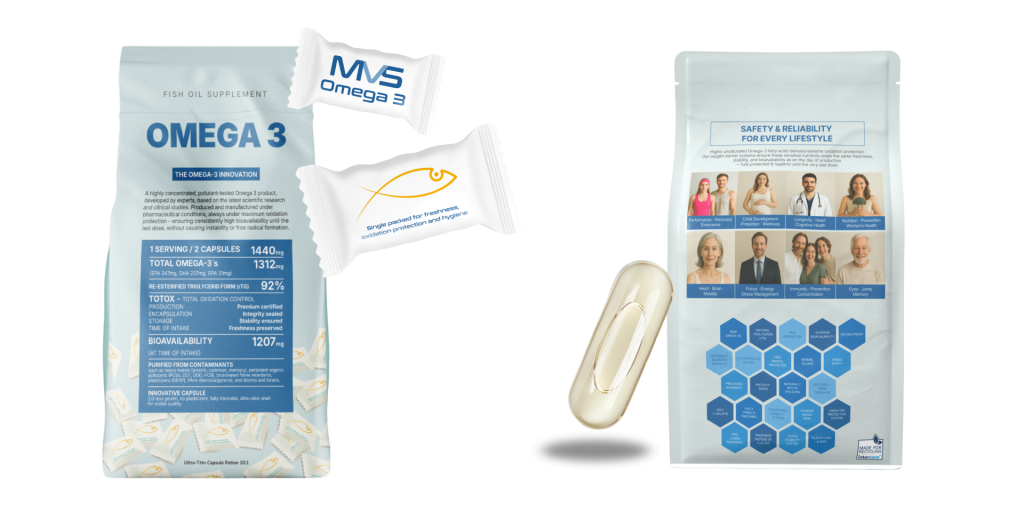Table of Contents
A Hidden Threat in Fish Oil
Omega-3 supplements are prized for supporting heart, brain, vision, pregnancy, and immune health. Yet their marine origin brings a critical risk: contamination with toxic heavy metals such as mercury, cadmium, and lead.
While high-quality purification methods can minimize this risk, studies show that supplements from less-regulated markets often exceed safe limits. Understanding how toxic metals get into fish oil — and how to choose supplements that are safe — is essential in 2025.
The Most Common Toxic Metals in Omega-3 Supplements
- Mercury
- Source: accumulates in large predatory fish (tuna, swordfish, shark).
- Risks: neurotoxic; damages the brain, spinal cord, and fetal development.
- Vulnerable groups: pregnant women, nursing mothers, infants, and children.
- Cadmium
- Source: enters oceans through industrial waste, mining runoff, and fertilizers.
- Risks: accumulates in the kidneys, liver, and bones; linked to kidney damage, hypertension, and cancer.
- Cumulative: even low-level exposure builds up over time.
- Lead
- Source: industrial discharge, contaminated sediments.
- Risks: affects neurological development, IQ, behavior, and cardiovascular health.
- No safe threshold: even minimal lead exposure is considered dangerous.
Why are They Found in Most Omega-3/Fish Oil Supplements?
Fish, especially large predatory species, can accumulate heavy metals from their environment, primarily through the food chain. Heavy metals can be present in some fish oil supplements due to contamination of the fish used to extract the oil, or other factors such as:
- Bioaccumulation: Fish at the top of the food chain, such as tuna, shark, and swordfish, are more likely to accumulate heavy metals. This is because they consume smaller fish, which, in turn, may have ingested metals from their prey. The process of heavy metals accumulating in organisms higher up the food chain is known as bioaccumulation.
- Polluted Waters: Fish that live in waters that are contaminated with industrial pollutants, agricultural runoff, or other sources of heavy metals are more likely to contain elevated levels of these substances. Pollution in oceans and seas can lead to contamination of fish and, subsequently, fish oil.
- Quality of Fish Sourcing: The quality of the fish used to produce fish oil supplements can vary. If the fish are sourced from regions with higher levels of pollution or if the sourcing practices are not stringent, there is an increased risk of heavy metal contamination in the final product.
- Processing Methods: The methods used to extract and process fish oil can impact its purity. Some manufacturing processes may not adequately remove contaminants like heavy metals. High-quality supplements often undergo processes such as molecular distillation to reduce the levels of contaminants.
- Lack of Regulation: While there are regulatory standards for contaminants in fish oil supplements, the enforcement may vary. In some cases, supplements from less-regulated markets may have a higher risk of contamination.
In short: How Toxic Metals Enter Omega-3 Supplements
- Bioaccumulation → Small fish absorb metals from water; large fish eat them, accumulating higher concentrations.
- Polluted waters → Industrial runoff and agricultural chemicals contaminate marine ecosystems.
- Low-quality sourcing → Using large predatory fish increases risk.
- Processing shortcuts → Inadequate purification leaves metals in the final product.
- Weak regulations → Supplements from less-regulated countries often exceed safety limits.
What are the regulatory guidelines for Omega-3 and toxic metals in 2025?
Mercury (methylmercury):
– EPA/WHO: avoid high-mercury fish; safe intake ≈ 0.1 µg/kg body weight/day.
-FDA: pregnant women should consume only 2–3 servings of low-mercury fish weekly.
Cadmium:
– JECFA: Provisional Tolerable Monthly Intake = 25 µg/kg body weight.
– OSHA: workplace limit = 0.005 mg/m³ over 8 hours.
Lead:
– CDC reference level in children: 5 µg/dL blood (no safe threshold).
– EPA drinking water action level: 15 ppb.
– OSHA workplace limit: 50 µg/m³ over 8 hours.
Why is Cadmium bad for your health?
Cadmium is considered harmful to human health due to its toxic properties and the fact that it can accumulate in the body over time. Here are some reasons why cadmium is considered detrimental to health:
- Toxicity: Cadmium is a heavy metal that can be toxic to various organs and systems in the body, including the kidneys, lungs, and bones. It is classified as a Group 1 human carcinogen by the International Agency for Research on Cancer (IARC), meaning there is sufficient evidence to support its carcinogenicity to humans.
- Accumulation: Cadmium tends to accumulate in the body, especially in the kidneys. Prolonged exposure to even low levels of cadmium can result in the gradual build-up of the metal in tissues, leading to chronic health issues.
- Kidney Damage: One of the primary concerns with cadmium exposure is its potential to cause kidney damage. Long-term exposure can contribute to the development of renal dysfunction and may increase the risk of chronic kidney disease.
- Bone Effects: Cadmium can interfere with calcium metabolism and accumulate in bones. Prolonged exposure may lead to a decrease in bone density, potentially contributing to skeletal issues.
- Respiratory Issues: Inhalation of cadmium dust or fumes can cause respiratory irritation and may lead to lung damage over time. Occupational exposure, such as in certain industrial settings, poses a particular risk.
- Cardiovascular Effects: Some studies suggest a possible association between cadmium exposure and cardiovascular diseases. Cadmium may contribute to the development of hypertension and increase the risk of cardiovascular events.
- Reproductive and Developmental Concerns: Cadmium exposure has been linked to adverse effects on reproductive health and development. It may impact fertility and has been associated with developmental issues in infants exposed in utero.
Given these health concerns, it is important to minimize exposure to cadmium.
Why is Lead bad for your health?
Lead is harmful to human health due to its toxic properties. Exposure to lead can have a range of adverse effects, such as:
- Neurological Effects: One of the most significant concerns with lead exposure is its impact on the central nervous system. Even low levels of lead exposure, especially in children, can result in cognitive and behavioral issues. Lead interferes with the normal development and functioning of the brain, leading to learning disabilities, decreased IQ, and behavioral problems.
- Developmental Delays: Children, particularly those exposed to lead during critical stages of development, may experience developmental delays and long-term cognitive impairments. Prenatal exposure to lead can affect the developing fetus, leading to issues such as low birth weight and developmental deficits.
- Behavioral and Emotional Effects: Lead exposure has been linked to changes in behavior and mood, including increased aggression, impulsivity, and irritability. These effects may persist into adulthood, impacting mental health and overall well-being.
- Gastrointestinal Issues: Lead can affect the gastrointestinal system, leading to symptoms such as abdominal pain, constipation, and nausea.
- Hematological Effects: Lead interferes with the synthesis of hemoglobin, the oxygen-carrying component of red blood cells. This can result in anemia, particularly in cases of chronic lead exposure.
- Cardiovascular Effects: Elevated lead levels in the blood have been associated with an increased risk of hypertension (high blood pressure) and cardiovascular diseases. Lead exposure can contribute to damage to blood vessels and the heart.
- Kidney Damage: Lead is known to accumulate in the kidneys, where it can cause nephrotoxicity (kidney damage). Prolonged exposure to lead may impair kidney function and contribute to chronic kidney disease.
- Reproductive Issues: Lead exposure can affect reproductive health in both men and women. In women, it may lead to miscarriages, premature births, and developmental issues in newborns. In men, lead exposure has been associated with decreased fertility and abnormalities in sperm.
Why is Mercury bad for your health?
Mercury is considered harmful to human health due to its toxic properties. Mercury exposure can lead to a range of adverse health effects, and the severity of these effects depends on factors such as the form of mercury, the level of exposure, and the duration of exposure. Here are some reasons why mercury is considered detrimental to health:
- Neurotoxicity: Mercury has a pronounced affinity for the nervous system and is known to be neurotoxic. It can cross the blood-brain barrier and interfere with the normal functioning of nerve cells. Prenatal exposure, especially during the early stages of fetal development, can result in developmental delays and neurological issues in children.
- Kidney Damage: Mercury can accumulate in the kidneys, leading to nephrotoxicity. Chronic exposure to mercury can contribute to kidney damage and impair the organ’s ability to filter and excrete waste products.
- Cardiovascular Effects: Some studies suggest that mercury exposure may be associated with cardiovascular issues, including an increased risk of heart attacks and hypertension. However, the evidence in this area is still being studied, and the relationship between mercury exposure and cardiovascular health is complex.
- Respiratory and Immune System Effects: Inhalation of mercury vapors, typically released from certain industrial processes, can cause respiratory irritation. Mercury exposure may also affect the immune system, potentially leading to immune dysfunction.
- Developmental and Reproductive Effects: Pregnant women are particularly vulnerable to the harmful effects of mercury. It can cross the placenta and impact the developing fetus, leading to cognitive and developmental issues. In adults, mercury exposure can impact reproductive health and may contribute to fertility problems.
- Methyl mercury Poisoning: Methyl mercury, a form of organic mercury, is of particular concern. It accumulates in certain fish and seafood, posing a risk to individuals who consume contaminated fish regularly. Long-term exposure to high levels of methyl mercury can lead to mercury poisoning, with symptoms including neurological disturbances, muscle weakness, and sensory impairments.
Health Risks of Toxic Metals in Fish Oil Summary
Health risks of toxic metals in fish oil supplements: key takeaways
Mercury:
– Cognitive impairment, developmental delays, and memory issues.
– Prenatal exposure → lower IQ, poor motor skills in children.
– Cardiovascular risks (arrhythmias, hypertension).
Cadmium
– Kidney damage and reduced bone density.
– Hypertension and increased cancer risk.
– Long half-life (10–30 years), making accumulation dangerous.
Lead:
– Neurological decline and higher dementia risk with long-term exposure.
– Reduced IQ, behavioral problems in children.
– Increased cardiovascular disease risk in adults.
Heavy metals in seafood
In order to ascertain the quality of various canned and packaged seafood products available in the U.S., Consumer Lab (a leading provider of consumer information and independent evaluations of products that impact health and nutrition) conducted a comprehensive evaluation(1).

The focus of the assessment included popular tuna, salmon, and sardines. Each product underwent testing for the presence of omega-3 fatty acids such as DHA, EPA, and DPA, along with omega-7 fatty acids. Additionally, rigorous scrutiny was applied to identify potential contamination with mercury, arsenic, lead, and cadmium. Consumer Lab’s evaluation also extended to the assessment of the oil in these products, aiming to discern its freshness or potential rancidity.
The comprehensive testing results revealed substantial variations in the omega-3 fatty acid content among different seafood products when consumed at recommended serving sizes. Notably, sardines and salmon emerged as particularly rich sources, providing significantly higher amounts of DHA and EPA compared to tuna. A standard 85-gram serving of sardines delivered an impressive 1,600 mg to 1,800 mg of DHA and EPA, while a 56-gram serving of salmon offered 400 mg to 700 mg. In contrast, canned and packaged tuna exhibited lower levels, ranging from 45 mg to about 440 mg of DHA and EPA per serving.
An exception was noted with one albacore tuna product, boasting 1,294 mg of DHA and EPA per serving. Furthermore, it was observed that some products contained substantially lower amounts of DHA and EPA than indicated on their labels.
To steer clear of contaminating your body with these heavy metals, you shouldn’t consume fish high in mercury more than once or twice per week. Furthermore, fish or seafood, high in arsenic, should not be eaten more than once daily. However, in the analysis, it was found that among the canned seafood options, salmon exhibited the lowest levels of mercury and arsenic. On the other hand, while canned sardines were found to be low in mercury, they displayed elevated levels of arsenic, ranging from 2.13 to 2.17 ppm.
-
How to Choose a Safe Omega-3 Supplement
– Sourcing: Small fish (anchovies, sardines, mackerel) accumulate fewer metals than large predators.
– Purification: Molecular distillation and advanced refining remove contaminants.
– Certification: Look for IFOS, GOED, or third-party lab testing.
– Transparency: Brands should disclose safety testing for heavy metals.
– Manufacturing location: Countries with strict GMP/ISO standards (like Germany) ensure compliance.The Role of Packaging in Metal Safety: Even after purification, poor packaging can allow oxidation, which interacts with trace metals to accelerate rancidity. Individually sealed capsules in oxygen-proof pouches offer the highest stability.
Summary: Heavy Metals Are Avoidable — If You Choose Wisely
Toxic metals in Omega-3 supplements are a real but preventable risk. Mercury, cadmium, and lead can harm the brain, heart, kidneys, and development, especially in vulnerable groups.
The solution lies in responsible sourcing, advanced purification, rigorous testing, and protective packaging. In 2025, the best Omega-3 supplements are those that combine safety, stability, bioavailability, and transparency — just like MVS Omega-3, which is setting a new benchmark for consumer trust.
MVS Omega-3 — Setting a New Standard in Purity, Stability, and Bioavailability
Developed by MVS Pharma’s medical and pharmaceutical experts, MVS Omega-3 represents a new generation of scientifically designed Omega-3 supplements. With a 92% natural rTG structure, verified bioavailability of 1207 mg, and our proprietary T-TOX™ oxidation control system, it ensures exceptional purity, stability, and absorption. Each batch meets European Pharmacopeia standards and is tested for over 20 potential contaminants — setting a benchmark for transparency and trust in modern nutritional science.

Not all Omega-3 supplements are created equal. The more unsaturated and effective Omega-3 molecules become, the more sensitive they are to air exposure — making oxidation protection the single most critical factor for preserving both safety and bioavailability. Once oxidation begins, oil turns rancid, loses efficacy, and may even generate free radicals.
At MVS Pharma, this challenge defined our mission. We engineered MVS Omega-3 as a next-generation formulation designed for uncompromised purity, verified stability, and maximum biological usability.
Key Facts:
- Pharma-Standard Purification & Testing — each batch is verified to meet European Pharmacopeia standards and is screened for over 20 contaminants, including heavy metals, PCBs, dioxins, PAHs, and plasticizers.
- 90% Purified Omega-3 Concentration — delivering 1440 mg total oil with 1312 mg active Omega-3s (EPA 784 mg, DHA 518 mg) per serving.
- 92% Re-esterified Triglyceride (rTG) Form — structurally identical to natural fish oil for superior absorption (1207 mg bioavailable) and full physiological compatibility.
- T-TOX™ Total Oxidation Control System — exclusive German oxidation-management technology ensuring freshness and molecular integrity from production to the last capsule.
- Innovative Double Packaging — Individually Sealed Protection. Each capsule is individually sealed in an oxygen-free, double-wrapped container filled with argon gas. This advanced protective solution shields the sensitive Omega-3 oil from oxidation, light, and moisture — preserving the purity, stability, and freshness of each capsule until the very last dose.
- Ultra Thin Capsule Release 3.0™ — 2/3 less gelatin, no plasticizers, and >91% active ingredient load for transparency, purity, and optimized payload.
- Natural Tocopherol Matrix (α, β, γ, δ) — balanced antioxidant system calibrated to protect high-purity oil without destabilization.
The result is an ultra-pure, oxidation-protected Omega-3 supplement that maintains its natural structure, freshness, and full efficacy until the final dose — ensuring consistent support for cardiovascular, cognitive, visual, and immune health.
Disclaimer: As a service to our readers, MVS Pharma GmbH publishing provides access to our library of archived content – in our blog. Please note the date of last review or update on all articles. No content on this site, should ever be used as a substitute for direct medical advice from your doctor or other qualified clinician.
FAQs
-
Which toxic metals are found in fish oil?
Mercury, cadmium, and lead are the most common contaminants.
-
Why are Omega-3s at risk of contamination?
Because fish absorb metals from polluted waters, especially large predatory species.
-
Is mercury in supplements dangerous?
Yes. Mercury is neurotoxic and especially harmful for pregnant women and children.
-
Are plant-based (algae) Omega-3s safer?
Yes. Algal oil is naturally free from heavy metals and ideal for vegans or those concerned with contamination.
-
How can I avoid heavy metals in Omega-3 Supplements?
Choose supplements made from small fish, purified via molecular distillation, and third-party tested.
-
Do regulations protect against metals in supplements?
Yes, but enforcement varies by region. High-quality brands test every batch.
-
Why are small fish safer than large fish?
They sit lower on the food chain, meaning less bioaccumulation of metals.
-
Can packaging help prevent contamination?
Packaging prevents oxidation, which can worsen metal-related instability.
-
What certifications should I look for in Omega-3 supplements?
IFOS, GOED, or independent lab tests confirming safety and purity.
-
What makes MVS Omega-3 different?
It offers oxidation resistance, superior absorption in rTG form, full safety testing, and double protection packaging — ensuring purity and potency from production to consumption.
Sources:
- Consumer Lab Tests Reveal Amounts of Omega-3s and Toxic Heavy Metals in Canned and Packaged Fish
- National Library of Medicine – “The function of omega-3 polyunsaturated fatty acids in response to cadmium exposure”
- Research Gate – “Omega-3 Fatty Acids versus Heavy Metals: A Quantitative Estimation of the Benefit-Risk Ratio for the Consumption of Commonly-Consumed Fish and Products in Metro Manila”
- Academic Journals – “Determination of mercury and cadmium levels in omega-3 food supplements available on the Ghanaian market”
- Evidence-Based Medicine Consult – “Fish Oil (Omega-3 Fatty Acid) Supplements and Mercury Content”
- KDU Library, Sri Lanka – “Analysis of Heavy Metals in Omega-3 Fish Oil Soft Gels Commercially Available in the Sri Lankan Market”


